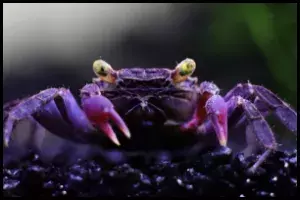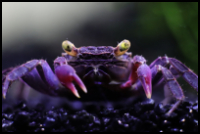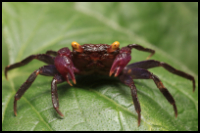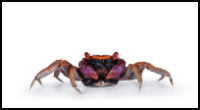



Quick Care Details (Table)
| Livestock Characteristics | Value |
|---|---|
| Care Level | Moderate |
| Temperament | Peaceful |
| Diet | Omnivorous |
| Maximum Size | 1.5 inches (3.8 cm) |
| Minimum Tank Size | 10 gallons |
| Plant Safe | Yes |
| Temperature Range | 72-82°F (22-28°C) |
| PH Range | 6.5-7.5 |
| KH Range | 3-8 dKH |
| GH Range | 6-12 dGH |
Species Specific Categories
Helpful Video
Care Details
Aquascape: Purple Vampire Crabs prefer a semi-aquatic setup with both land and water areas. Provide a mix of smooth rocks, driftwood, and live plants like mosses and ferns to create a naturalistic environment.
Substrate: Use a mix of sand and fine gravel for the aquatic area, and coconut fiber or peat moss for the land area. This allows for burrowing and maintaining humidity.
Disease Prevention: Maintain clean water conditions and avoid overcrowding. Quarantine new additions and regularly inspect for signs of disease or parasites.
Filtration: A gentle sponge filter or low-flow filtration system is suitable. Ensure the filter intake is covered to prevent crabs from getting trapped.
Lighting: Low to moderate lighting is sufficient. LED lights that simulate natural daylight can be used to enhance the visual appeal of the habitat.
Water Flow: Minimal water flow is ideal, as these crabs prefer still or slow-moving water. Avoid strong currents that can stress them.
Hardiness: Purple Vampire Crabs are generally hardy once acclimated to their environment. They tolerate a range of water parameters but prefer slightly acidic to neutral water (pH 6.5-7.5).
Acclimation: Gradually acclimate crabs to their new habitat by floating the transport bag in the tank and adding small amounts of tank water over time.
Expected Lifespan: With proper care, Purple Vampire Crabs can live up to 2-3 years in captivity.
Special Requirements: Provide hiding spots and climbing structures above the waterline. Maintain high humidity levels (around 70-80%) in the land area to prevent desiccation.
Temperament and Behavior
Behavior: Purple Vampire Crabs are generally peaceful but can be territorial, especially towards their own kind. They are active both on land and in the water, often foraging and exploring their environment.
Breeding: Breeding Purple Vampire Crabs in captivity can be challenging. It typically requires a brackish water phase for larvae development, followed by reintroduction to freshwater. Breeding behaviors include courtship displays and mating rituals.
Aggression: They can exhibit aggression towards each other, particularly males competing for territory or during mating. Provide ample space and hiding spots to minimize aggression.
Tankmates Compatibility: Compatible tankmates include small, peaceful fish like tetras and rasboras, as well as non-aggressive shrimp and snails. Avoid keeping them with larger or more aggressive species that may prey on or harass them.
Activity Level: These crabs are active scavengers and climbers. They spend time both in the water and on land, exploring and searching for food.
Schooling or Shoaling Behavior: Purple Vampire Crabs are not schooling or shoaling animals. They are solitary and prefer their own space, especially during molting or breeding.
Plant Compatibility: Live plants that can tolerate occasional contact with brackish water conditions are suitable. Hardy plants like Java fern, Anubias, and mosses work well and also provide cover.
Diet and Nutrition
Dry Foods: Offer high-quality crab or shrimp pellets, sinking fish flakes, and occasional algae wafers. These provide essential nutrients and can be readily accepted.
Frozen Foods: They enjoy frozen bloodworms, brine shrimp, and daphnia as treats. Thaw before feeding to ensure they can consume them easily.
Live Foods: Live foods like small insects, worms, and plankton are excellent for their diet. They stimulate natural foraging behavior and provide necessary protein.
Vegetables: Include blanched vegetables like spinach, zucchini, and cucumber. These provide fiber and essential vitamins.
Algae: Purple Vampire Crabs will graze on algae naturally growing in the tank. Supplement their diet with algae wafers to ensure they get enough greens.
Feeding Schedule: Feed once a day, offering a variety of foods to ensure a balanced diet. Adjust amounts based on their consumption to avoid overfeeding and water quality issues.
Supplemental Foods: Consider calcium supplements or cuttlebone for extra calcium, crucial for shell health during molting.
Tank Parameters
Tank size: A 10-gallon tank or larger is suitable for a small group of Purple Vampire Crabs. Provide adequate space for both land and water areas.
Tank Length and Measurements: Dimensions should allow for a varied habitat with at least 50% of the tank dedicated to a land area with hiding spots and climbing structures.
Water Temperature: Keep the water temperature between 72-82°F (22-28°C). Provide a warmer area under the basking light for terrestrial activities.
pH (Acidity/Alkalinity): Maintain a slightly acidic to neutral pH range of 6.5-7.5. Monitor pH levels regularly, especially after water changes.
KH (Carbonate Hardness): Aim for a carbonate hardness (KH) of 3-8 dKH to stabilize pH and maintain water quality.
GH (General Hardness): The general hardness (GH) should be around 6-12 dGH, ensuring adequate mineral content for shell health and overall well-being.
Hardiness: Purple Vampire Crabs are hardy once acclimated but are sensitive to sudden changes in water parameters. Ensure gradual acclimation when introducing them to new water conditions.
Nitrate (NO3) levels: Keep nitrate levels below 20 ppm through regular water changes and proper filtration. Elevated nitrate levels can stress crabs and affect their health.
History, Popularity, History and Species Variety Details
History: Purple Vampire Crabs, scientifically known as Geosesarma dennerle, were first discovered and introduced to the aquarium hobby relatively recently. They are named after their distinctive purple coloration and are native to freshwater habitats in Southeast Asia, particularly in regions with a mix of land and water areas. Initially found in hobbyist circles focusing on exotic and unique aquatic species, their popularity has grown steadily due to their striking appearance and fascinating behavior.
Popularity: Geosesarma dennerle, or Purple Vampire Crabs, have gained popularity among aquarium enthusiasts who appreciate their vivid colors and semi-aquatic lifestyle. They are sought after for their ability to thrive in setups that mimic their natural habitat, providing both land and water areas within the aquarium. Their intriguing behavior, such as climbing, burrowing, and scavenging, adds to their appeal as unique additions to freshwater tanks. Despite their relative rarity compared to more common aquarium species, dedicated hobbyists and breeders continue to promote and enjoy keeping them.
Natural Habitat: In their natural habitat, Purple Vampire Crabs inhabit forested areas near streams and rivers in regions of Indonesia. These crabs are adapted to environments where they can move between land and water, often spending time in moist, shaded areas with access to both fresh water and terrestrial vegetation. They are omnivorous scavengers, feeding on a variety of plant matter, small invertebrates, and detritus found in their surroundings. This natural behavior influences their care requirements in captivity, emphasizing the need for a balanced diet and suitable habitat that mimics their native ecosystem.
Similar and Variations of the Species:
- Geosesarma hagen: Known for its vibrant red coloration and similar habitat preferences.
- Geosesarma tiomanicum: Exhibits a striking blue coloration and requires similar semi-aquatic conditions.
- Geosesarma notophorum: Features a patterned shell and shares the same habitat preferences as other Geosesarma species.
These variations within the Geosesarma genus offer hobbyists a range of colors and patterns while requiring similar care and environmental considerations. Each species showcases unique adaptations and behaviors reflective of their natural habitats in Southeast Asia.
Frequently Asked Questions
Can Purple Vampire Crabs live completely underwater?
No, they are semi-aquatic and need access to both water and land areas in their habitat.
What do Purple Vampire Crabs eat?
They enjoy a varied diet including pellets, frozen foods like bloodworms and brine shrimp, live insects, and blanched vegetables.
Are Purple Vampire Crabs compatible with other fish?
They can coexist with small, peaceful fish like tetras and rasboras, as well as non-aggressive shrimp and snails.
How do you set up a tank for Purple Vampire Crabs?
Provide a mix of sand and gravel substrate, with rocks, driftwood, and live plants for climbing and hiding.
Do Purple Vampire Crabs need a heated tank?
Yes, they thrive in temperatures between 72-82°F (22-28°C), with a warm basking spot for terrestrial activities.
How long do Purple Vampire Crabs live?
With proper care, they can live up to 2-3 years in captivity.

